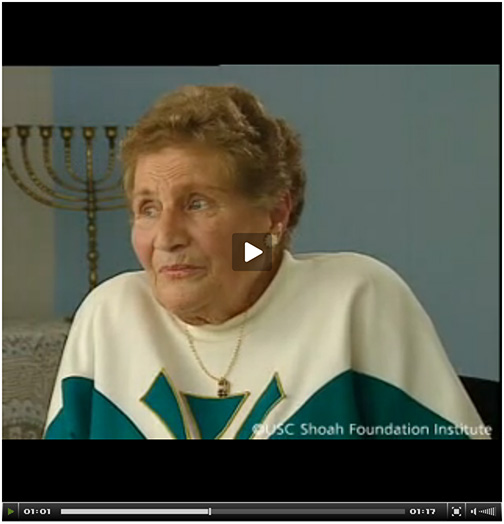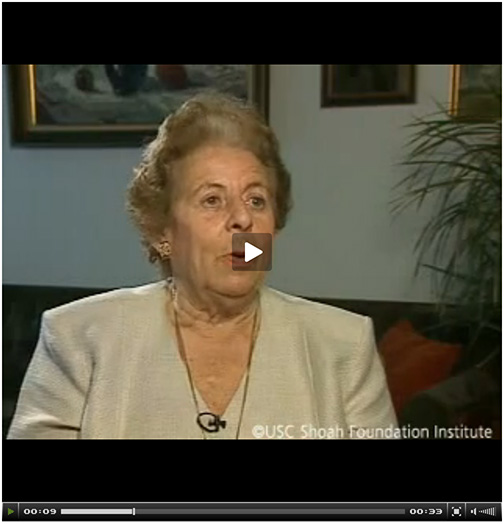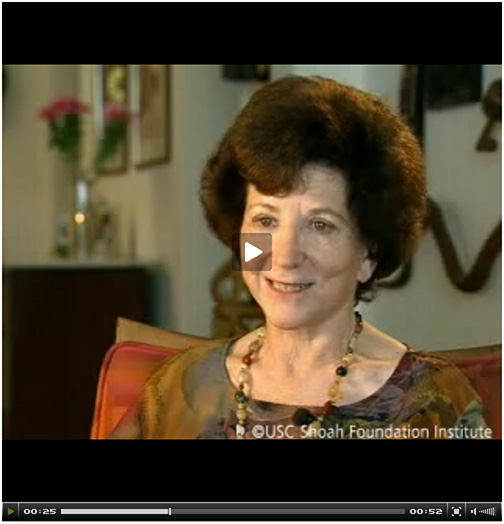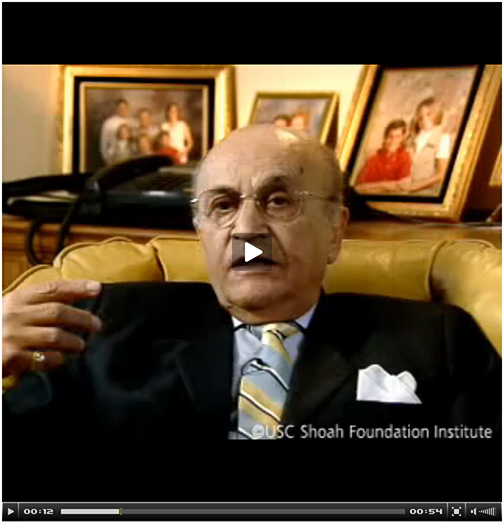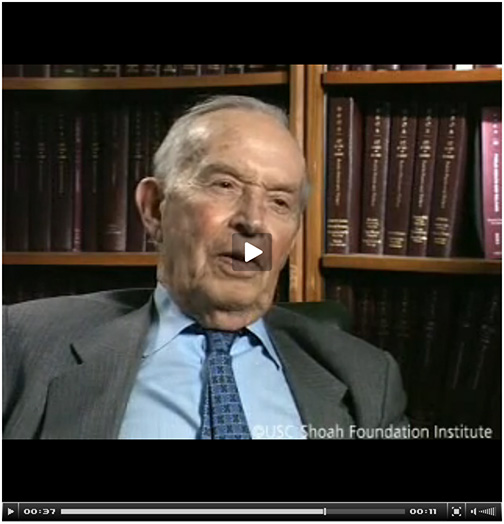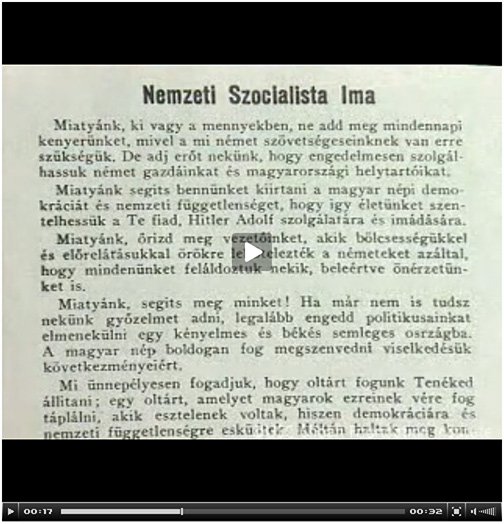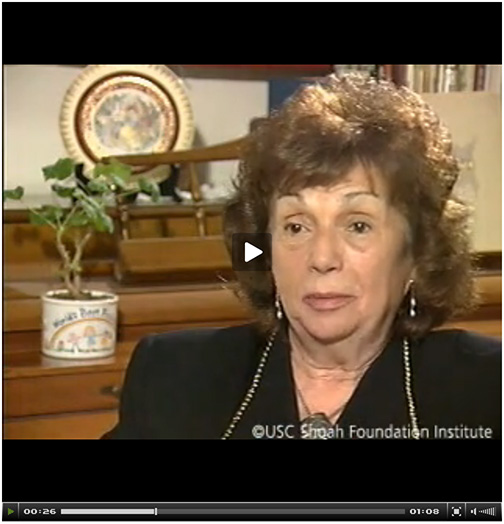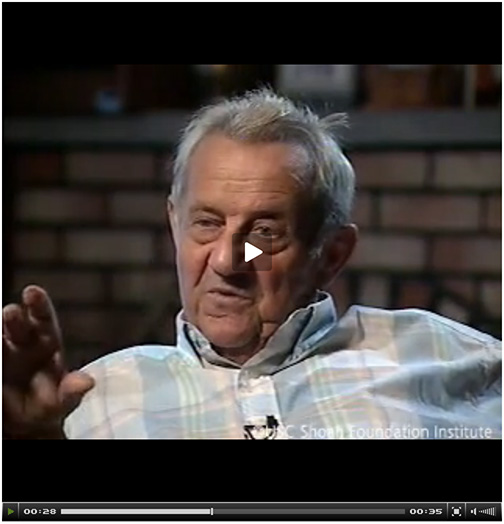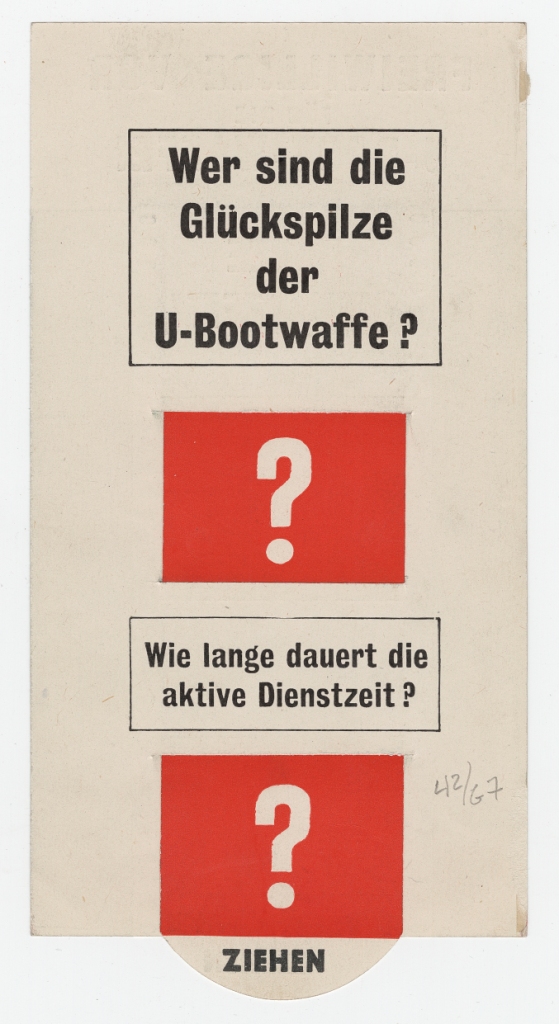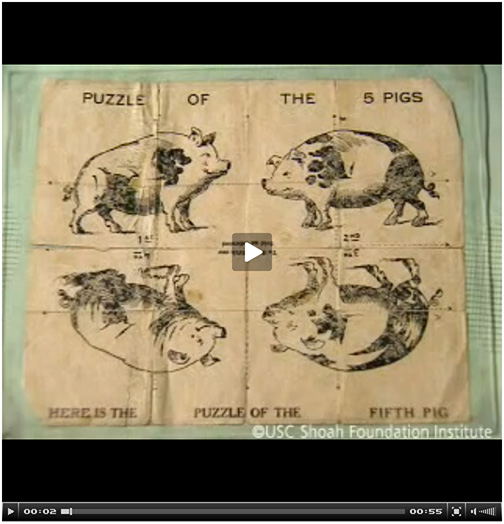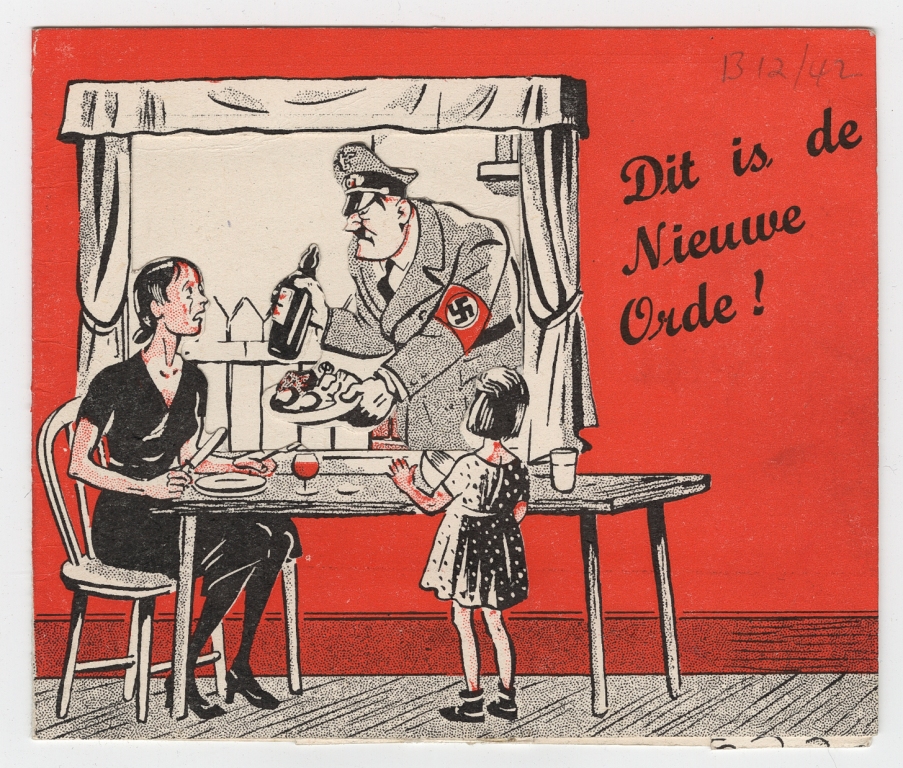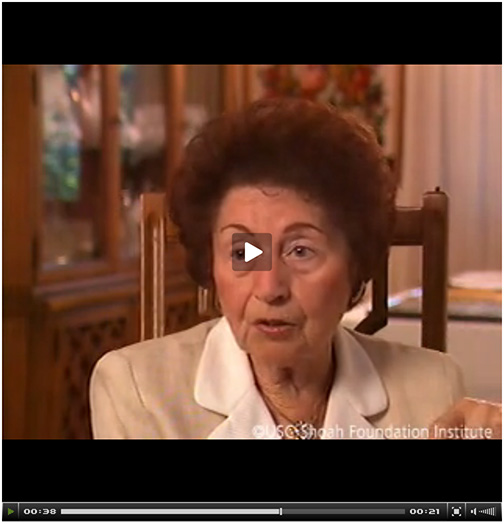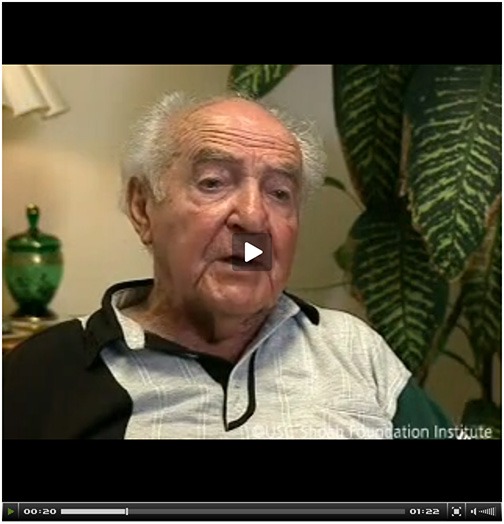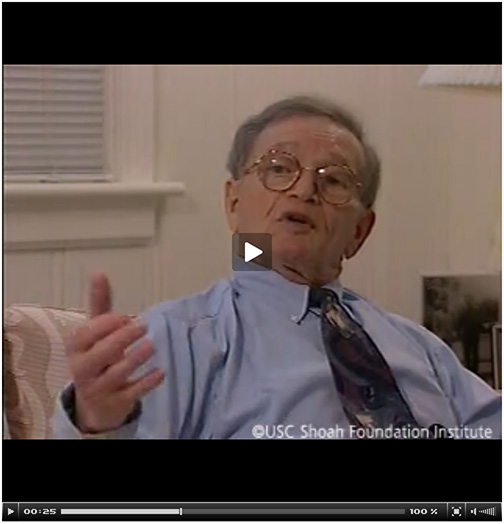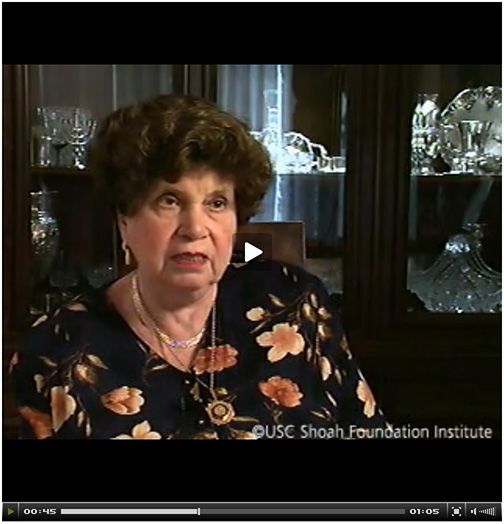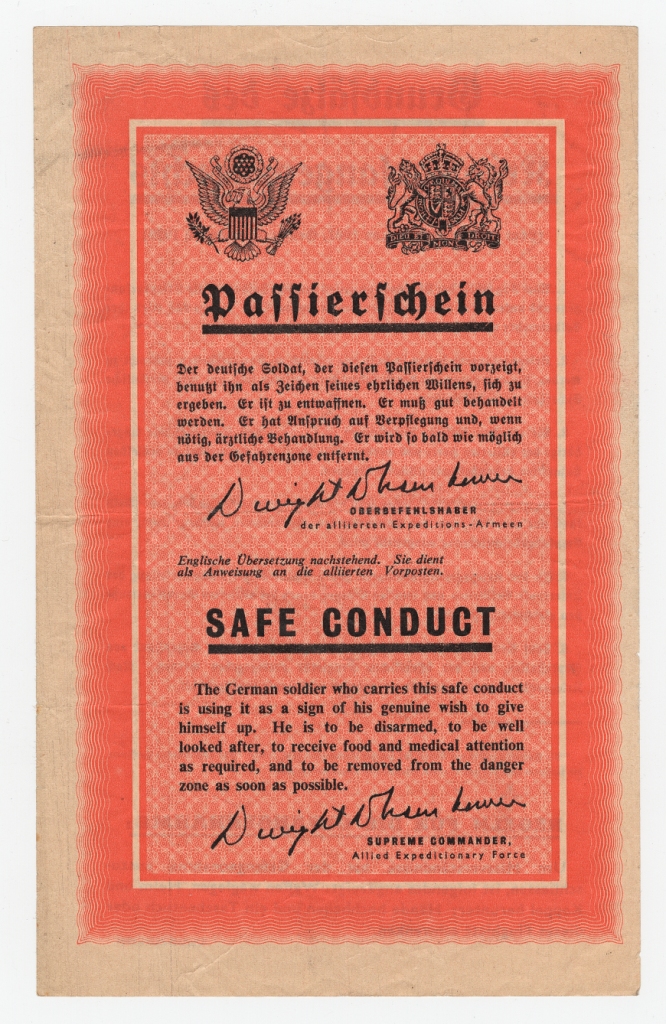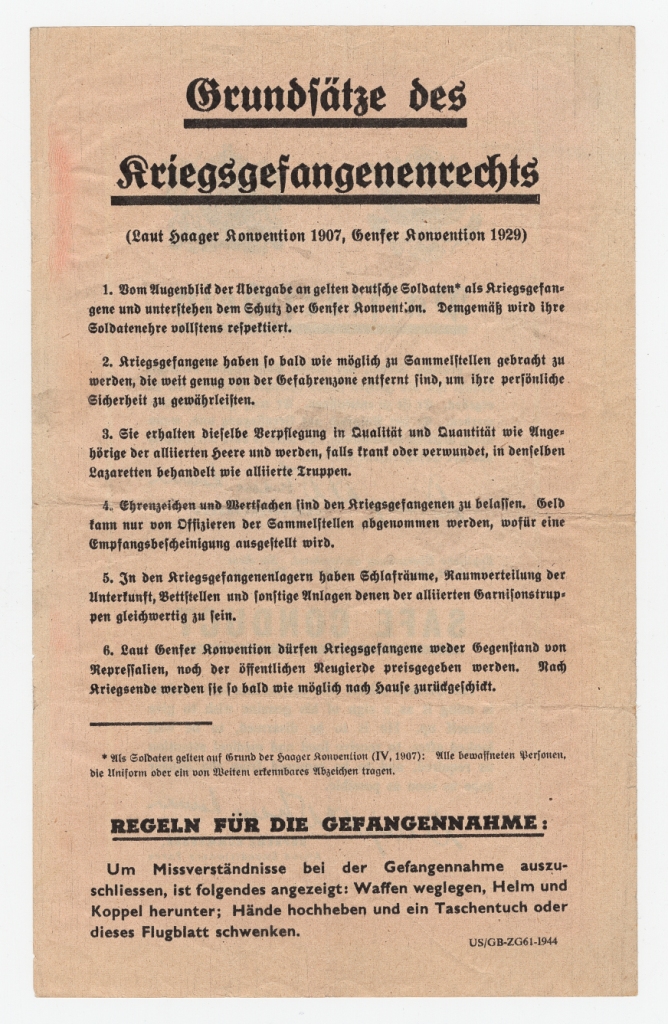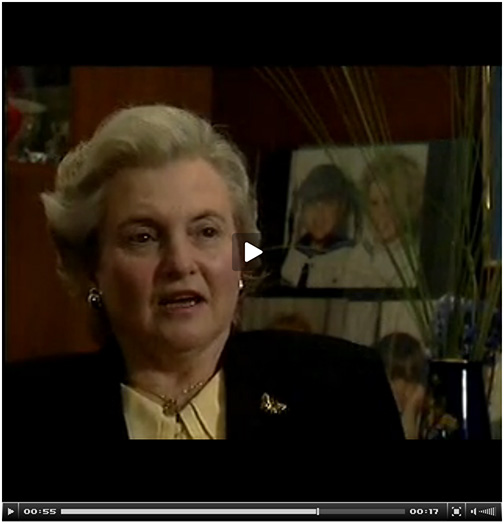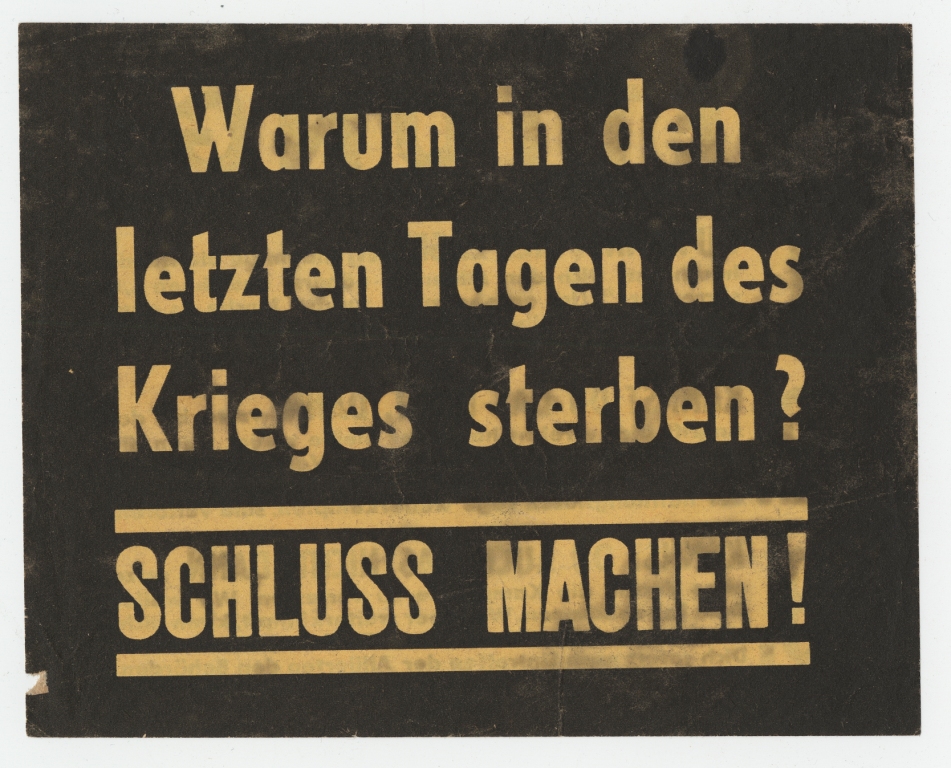The Propaganda Collection, acquired from Michel Brisebois, consists of over 1,000 air dropped and shelled leaflets and periodicals created and disseminated during the Second World War. The majority of items in this collection were printed by the Allies and then air or container dropped, or fired by artillery shell over German-occupied territory. Many leaflets and periodicals have original publication codes and materials in the collection were printed in over 10 languages. Only the shelled leaflets, Germans to Allies (115 items), are in English. The full list of items can be found in the finding aid to the collection.
"The leaflets gave us hope"
The planes dropped leaflets, and everyone rushed to get them. And then Hess, the commandant, said "If you people think that your liberation comes from there (and he pointed at the planes), you are mistaken, your liberation comes from there (and he pointed at the chimneys). You are never going to come out; you can leave only through the chimneys." So we knew that we will not come out alive. But there was some hope that they knew about us. We thought these were the British planes. I think that it said that Italy has already been liberated, so it gave us hope. It was autumn of 1944.[*]
One night, it was a night of thunder and raining, and we saw English planes, going through the sky and there were some strips, aluminum strips that they dropped off from the plane. And people had kept the aluminum, and said, [these are] messages for the French people that [the] English and perhaps Americans, want to tell us “be courageous, by gum” or something. And to read it we had to drop them in vinegar; of course the real aim was to hide it from the radar. [*]
One day, in the beginning of April 1945, we got a note from the British airplane saying “do not worry; we will be marching the next day, at 10 o’clock. And next day they came but the Germans left the night before.[*]
I escaped from the camp... I saw a pile of papers flying into the air. I went to pick it up, since I always needed the toilet paper… It was a pile of leaflets, rectangular sheets of paper… The first one said, in German, "Germans, throw away your weapons, the war is over. Surrender. The Americans are closing in, the Russians are approaching, your Fuhrer has deserted you…" It was the most wonderful message I have ever received in my life. It did not do much in this barren field but it gave me a tremendous hope.[*]
Propaganda, as an essential side of war, is designed to lower the enemy’s morale and to discourage the civilian population from serving in the army or working for the war industry. Propaganda is also directed to persons in occupied countries, with proclamations supporting the local resistance and providing them with necessary information (war maps, news flashes, etc). The Brisebois collection holds a variety of propaganda materials that the Allies dispersed on Germany and German-occupied countries, as well as a smaller number of propaganda materials dropped by Germany on the Allied forces. The leaflets held at McMaster take various forms, from classical proclamations to more typical models of the mass culture, such as comic strips, caricatures, newspapers, and stickers. The archive also holds a number of airdropped newspapers, such as Le Courrier de l’Air, Luftpost, or L’Amerique en Guerre.
Introduced by the British R.A.F., the practice of psychological warfare was later adopted by the U.S. Army (Eighth Air Force). As J.M. Erdmann points out, "Leaflet operations toward the end of this great campaign resembled the publication mechanics of several large metropolitan newspapers, with “reporters” (intelligence collection specialists), writers and artists, layout men, printers, truck drivers, packers and security personnel, all working on a tight schedule.” For more effective dissemination, Captain James L. Monroe developed the unique “flying oatmeal box,” which could easily “be slung in the bomb bay of a heavy bomber and carried to its destination from a high altitude, yet could be set to burst close to the ground and scatter tens of thousands of leaflets in a dense blanket over the target.”[*]
"We were told to use all kinds of psychological tricks"
At age of 16 I went to work for the BBC. This section was broadcasting propaganda to Germany, true news and the music of Jewish composers. They also had the German POWs program, with the Germans who volunteered to speak their minds in the studio. They dictated their thoughts to little me, who typewrote them.[*]
I was writing leaflets in German; I was sent to the morale operation, we were broadcasting the news in German so that they know the truth.[*]
The various teams involved in psychological warfare worked on storylines, images, recurring characters, and the design of leaflets, with the intention of bringing enlightenment to and provoking despair in the enemy’s army. Lerner summarizes their basic techniques as factualism (everything needs to be truthful, otherwise confidence is lost) and indirection (“an estimate of the responses which the human organism makes to verbal symbols offered by the enemy in time of war”).[*] Nicolas Doman, a former member of the psychological warfare division, tells how he was first trained to write propaganda materials, and then assigned to “write in Hungarian the leaflets or pamphlets to be dropped in Hungary by the U.S. Air Force. The purpose of these leaflets was to convince the population not to support the Germans, because Germany was continuing to lose the war."
Doman also adds that “the text is factitious; we were told to use all kinds of psychological tricks in order to accomplish our purpose."[*]The common response to psychological warfare was ambiguous. Among the Allies, many officials as well as regular soldiers considered the dissemination campaign to be too dangerous and too ineffective. Erdmann notes that “pilots complained of wasting men in transporting “bumf,” while radio and journalist commentators began to talk of the “fungus of futility” that was creeping into the crews of Bomber Command.[*] In Germany, the people had to report any leaflets to the police immediately, and for prisoners in concentration camps picking up a leaflet was mortally dangerous. Camp prisoners could be punished or even executed on spot. A former prisoner of the Theresienstadt ghetto describes one instance of the dropping of leaflets from an aircraft:
We were out in the street. Some of the officers came out and then ran back to the administrative building. We laughed at him because there was no harm from these planes. The only thing that they dropped was leaflets, tons of leaflets that we were not allowed to pick up… You would be sent to Auschwitz or to the Little Fortress [the ghetto prison] if you pick up any leaflet.[*]
Another Holocaust survivor tells that when she was in school the teacher distributed leaflets among the students so that they could take them home to their parents. However, the Germans came, and the students, following the teacher’s instructions, ate the papers. The Nazis did not find anything at school and left; afterwards, the teacher said that the class saved her life.[*]
[At basic military training in the U.S.] they talked about how it was ‘kill-or-be-killed’, how bad the Germans were, but they did not talk anything about Germans and Jews… and as I look back on it, it is interesting because they talked about how they had come into the lowlands and destroyed people, taken people to France, and took all these countries, and then showed us pictures of England, and how England was standing off, alone, and fighting off the Germans and how horrible they were [to them], and [particularly] in every film about how it was kill or be killed. So I always said that they were training us to be low-paid hired assassins.[*]
Maps included in propaganda leaflets were intended to “present, vividly and without comment, the discouraging situation in which the Germans found themselves.” Important information was often delivered through pictures, sometimes paired with text, and with maps explaining the current front conditions and the movements of both military and civililian forces. Sometimes the propaganda message itself came in the form of maps, such as in this leaflet dropped by an RAF balloon in 1941 near the Belgian coast. In this document, a series of images illustrate “why Germany lacks the manpower.” Two images of European maps are used to illustrate statistics of countries that support the Allies and the Axis forces, respectively. On the first map showing Western Europe, we see the figures of soldiers placed on many countries, while the second shows only four figures placed on Italy, Sicily, Albania, and North Africa. Used together with the text, the maps effectively convey the message of the leaflet.
"This is the New Order"
I remember we caught a leaflet in the camp; they came down with empty gas containers. They were about air raids, about destroying Berlin. And one of their slogans said: "Leipziger, schlaft ruhig in den Betten, wir fahren nach Berlin zu den Feten" (You people from Leipzig can now sleep in peace, we are going to Berlin to knock the hell out of you.) This gave us some inspiration.[*]
Mimicking children's books or toys was another strategy that psychological warfare adopted by turning the leaflets into mechanical cards, pop-up books, comic strips, or even puzzles.[*] These forms turn out to be convenient due to their simplicity and the possibility to reveal some hidden and invariably shocking information. A mechanical card dating from 1942, as one example, shows a German sailor going out “against England” on a U-boat. Pulling the bottom of the card reveals a different image of the same soldier dying as his U-boat sinks. Instead of “We are going against England,” the text now reads, “We are going down into the cold grave.” At the same time, on the upper part of the card, the words “Short lasted duty!” are revealed. Once we see these disturbing images, we turn the card to the other side and read in more detail how quickly German submarines are often sunk. U-boat sailors who have evaded being sunk are called “the lucky survivors” and the average length of a U-boat crewman's service in active combat is evaluated as 62 days.
The fates of sailors in the German navy are further exploited in the comic strip “The life of a submariner,” dated from 1942. This leaflet, subtitled “Here are scenes from the submariner’s life; his life is short and rich in adventures” presents a set of pictures illustrating the life of an ordinary fellow named Guenther and his tragic death at sea. We see how this man is drafted into the Navy, how he endures all kinds of ordeals and suffering, and finally, the sinking of his ship. The leaflet emphasizes the fact that even after a submarine is destroyed, English sailors try to save the remaining Germans. The last two pictures show the man’s mother crying over the death notice with the explanation that the message was held by the Navy for four months, and Hitler addressing the Reichstag and proclaiming that more submarines must be built in order to have more “swimming coffins” for German boys like Guenther. As we see, the leaflet is designed to provoke despair in the enemy but at the same time to demonstrate compassion and pity over their fate.
The leaflets dropped on Nazi-occupied territories depict the Germans as being greedy and cruel, abusing their power and injuring the weak. A typical example is this picture that shows a Hitler-like figure offering a meal to a woman and her child. When the leaflet opens, we see that he actually takes the food away and passes it to a German officer. The leaflet is artistically designed as a pop-up card, and even supplied with the envelope thus giving the impression of a real letter.
Humor and satire were used widely in leaflets dropped on both the occupied countries and German territory. Making fun of German officers was one of the themes that recurrently appears on leaflets. They are pictured as fat, ridiculous, and laughable characters. A book of caricatures (The Third Reich in images) dropped on Belgium between December 1942 and February 1943 contains a series of cartoons depicting the life and morals of German officers with the following preambule:
In this small brochure, we are demonstrating your "masters" as they are. These pictures have been constantly printed in the Daily Express journal since the beginning of the war. They were drawn by an inspiring caricaturist Osbert Lancaster. Enjoy!
"The War is Over, Surrender!"
While we were digging the trenches in the camp, the airplanes came and dropped the leaflets. They said that the war is coming to the end, and it was for the Nazis. It said "don’t you dare to touch anyone; you are responsible from now on for every person."[*]
One of the most effective pieces I had designed was using photos from an actual German POW camp. I would use photos, and make a full description of the man, but the name would have a black rectangle obscuring it with the written question to the effect of: "Is this what we are fighting for?" on the opposite side would be written, "If you raise your arms up and surrender, you will be accepted, fed, bathed, and you will be free to ride home to your people." Presumably these would be dumped over German camps and stations to encourage them to give up the fight.[*]
We were being unloaded on the platforms, and trains were coming from all possible directions. They were still killing people. And then airplanes came over us, dropping leaflets. We took some of them, they were written in English and German. There were warnings to the guards of the trains, to the Germans. They said “We know you are carrying eastern prisoners. If you do any harm to them from now on, you will be executed on spot when the place is liberated. So better do not do anything to them, try to help them.[*]
When did you feel that this is the end of the war? – When they took us on the march I felt that the end is near… Nobody was too strict with us... Airplanes came overhead, throwing papers, the flyers. The SS allowed nobody to pick up the papers. But some people took them, and they shot them. My sister went into the forest and read it. She said that they told them not to touch us anymore. My sister saved the paper and later showed it to everybody. The spring was so nice! And I said that it could not last much longer.[*]
The VHA interviewees often tell how the British or American airplanes flew over their camp and disseminated leaflets addressing the Germans and encouraging them to stop fighting and give up. While the form of surrender documents varied, the most famous ones were Safe Conduct Passes (German Passierschein). Initially invented by the British Army, and then adopted by the U.S. forces, these leaflets come in various forms and designs, while the text never changes:
The back of the Safe Conduct is typically used either for translations (German, French, or sometimes Polish) or for the Hague treaty of 1929 that lists conditions in which Allied prisoners of war are kept. The details include information about housing, food rations, and a promise to be allowed to return home after the war is over. In some cases, the back of the Passerschein bears additional supporting information, mostly focusing on the bleak future of Wehrmacht:
At the front:
17-year olds with two-months training
Convalescents with untreated wounds
40- and 50-year-olds with guns
In a leaflet addressing the 19th Army: “If your Mothers, wives, your loved ones, and your children could speak, only one word would ring in your ears “END.” Hopeless struggle or honorable POWs. Death or Life. You have the choice!” After showing German soldiers all hopelessness of the whole campaign, the leaflet also gives them a solution, the document that will protect them if they surrender. According to Lerner, many German soldiers kept these leaflets “because it might come in useful. The mere fact that a German soldier hid a Passerschein in his pocket was a tiny but important psychological concession to Allied victory”[*]
On the website dedicated to the history of the Safe Conduct Passes, Herbert Friedman tells readers about “the alleged belief on the part of the Allies that the German officer or soldier would react in a positive way to an official looking document. Therefore, the Americans and British collaborated to produce a fancy official document bearing national seals and signatures that would rival a stock certificate.” The design had to resemble a “college diploma,” with as many features of the official document as possible.[*] Lerner says that “by 1944, the Passiershein had become almost the work of art.…It was found that a particular shade of green was the most persuasive color…that the text should not be printed only in German, but in parallel German, English, and French columns; and, most important of all, that it must have the signature of the Supreme Commander.”[*]
When the war was drawing to an end, U.S. air forces dropped surrender leaflets on German divisions urging them to stop fighting. Some survivors of the death marches tell how they witnessed the planes disseminating these leaflets among the soldiers. Magda Fischer was among the people being dragged through the mountains when the “American airplanes came; they were flying very low and dropping propaganda leaflets. Of course we were not allowed to take them but someone stole it, and the leaflets said in many languages to the Germans to give themselves up. It gave us hope."[*]
They ran out of materials to work with and work to do in the camps so they were forced to dig ditches in an open field for no purpose other than to keep them working.
“Lift your head and look." And we couldn’t believe what we saw:
Leaflets.
Millions.
Coming down.
Right away we hear ‘Achtung! Anybody picking up one of those gets shot.’
But you know something? So many came down that you couldn’t help it because they were all over you. We got a few into camp and this was, I think, a week or two weeks before the end of the war.
It was addressed to the German people, I don’t remember exactly, I wish I had held on to one. I wish I had held on to one.
‘You’ve killed enough. Stop your killing. You can’t bring back the ones you’ve killed. Stop your killing NOW.
That’s when we knew.[*]
NOTES
[1] Keating, Hansi. Interview 38342, Visual History Archive, USC Shoah Foundation Institute. 2014. Web. 16 May 2014.
[2] Itzkovitz, Max. Interview 26439, Visual History Archive, USC Shoah Foundation Institute. 2014. Web. 28 May 2014.
[3] Gotzler, Livia. Interview 47108, Visual History Archive, USC Shoah Foundation Institute. 2014. Web. 28 May 2014.
[4] Loben, Ernest. Interview 4365, Visual History Archive, USC Shoah Foundation Institute. 2014. Web. 29 May 2014.
[5] Erdmann, J. M. Leaflet operations in the Second World War: The story of the how and why of the 6,500,000,000 propaganda leaflets dropped on axis forces and homelands in the Mediterranean and European theaters of operations. Denver: Denver Instant Printing, 1969, 3-6
[6] Parker, Lore. Interview 3306, Visual History Archive, USC Shoah Foundation Institute. 2014. Web. 28 May 2014.
[7] Rodell, Fred. Interview 495547, Visual History Archive, USC Shoah Foundation Institute. 2014. Web. 28 May 2014.
[8] Lerner, Daniel. Psychological Warfare Against Nazi Germany: The Sykewar Campaign, D-Day to VE-Day. Cambridge, the MIT Press, 1971, 201-202
[9] Doman, Nicolas. Interview 38392, Visual History Archive, USC Shoah Foundation Institute. 2014. Web. 7 May 2014.
[10] Erdmann, J. M. Leaflet operations in the Second World War, 53-54.
[11] Beasley, Janet. Interview 29036, Visual History Archive, USC Shoah Foundation Institute. 2014. Web. 7 May 2014.
[12] Isaacman, Clara. Interview 24614, Visual History Archive, USC Shoah Foundation Institute. 2014. Web. 7 May 2014.
[13] Paul Parks, Interview 4513, History Archive, USC Shoah Foundation Institute. 2014. Web. 15 May 2014.
[14]] Literally, it means "We are going to Berlin to have a party." Koltun, Harry. Interview 19656, Visual History Archive, USC Shoah Foundation Institute. 2014. Web. 12 May 2014.
[15] Awner, Ruth. Interview 3298, Visual History Archive, USC Shoah Foundation Institute. 2014. Web. 7 May 2014.
[16] Kirschner, Sala. Interview 33589, History Archive, USC Shoah Foundation Institute. 2014. Web. 15 May 2014.
[17] Klinger, Walter. Interview 35951, History Archive, USC Shoah Foundation Institute. 2014. Web. 15 May 2014.
[18] Zimm, Alan. Interview 19207, Visual History Archive, USC Shoah Foundation Institute. 2014. Web. 15 May 2014.
[19] Farkas, Hilda. Interview 27897, Visual History Archive, USC Shoah Foundation Institute. 2014. Web. 7 May 2014.
[20] Lerner, Daniel. Psychological Warfare Against Nazi Germany, 341.
[21] Ibid., 340
[22] Fischer, Magda. Interview 32452, Visual History Archive, USC Shoah Foundation Institute. 2014. Web. 7 May 2014.
[23] Young, Phyllis. Interview 8359. Visual History Archive, USC Shoah Foundation Institute, 2014. Web 7 May 2014

